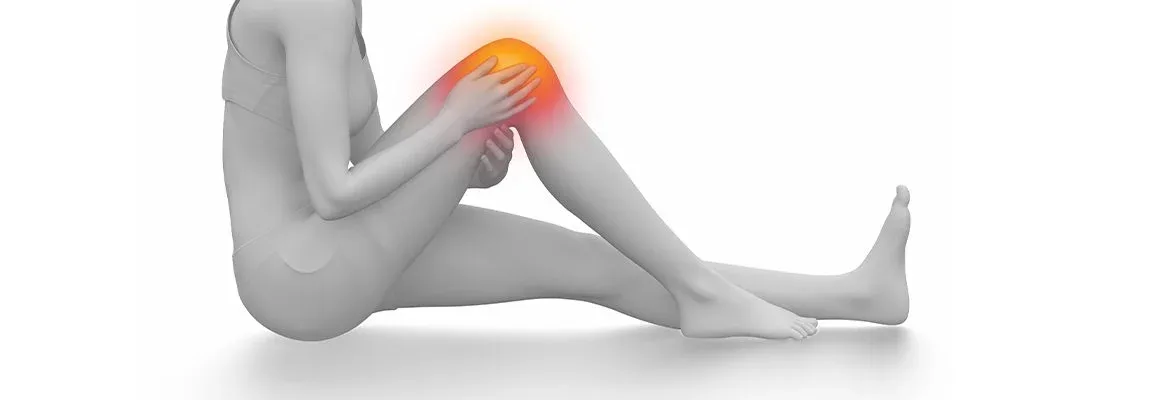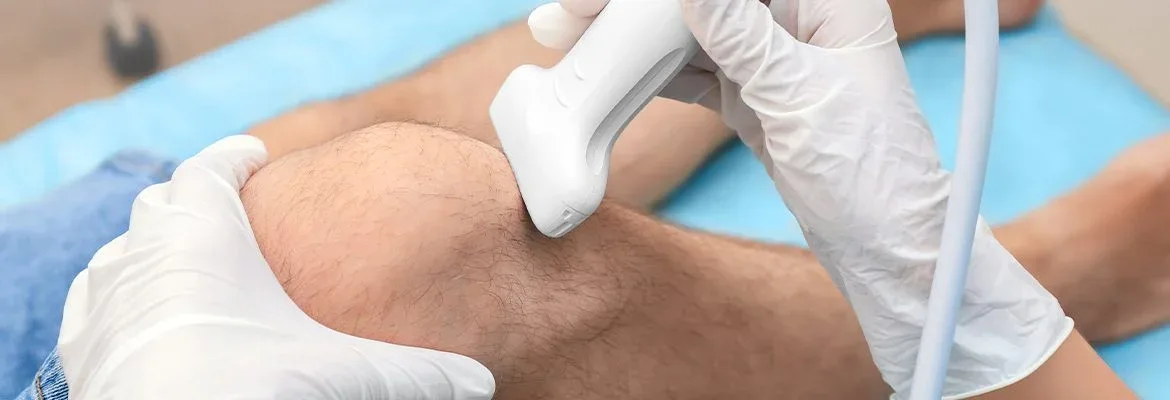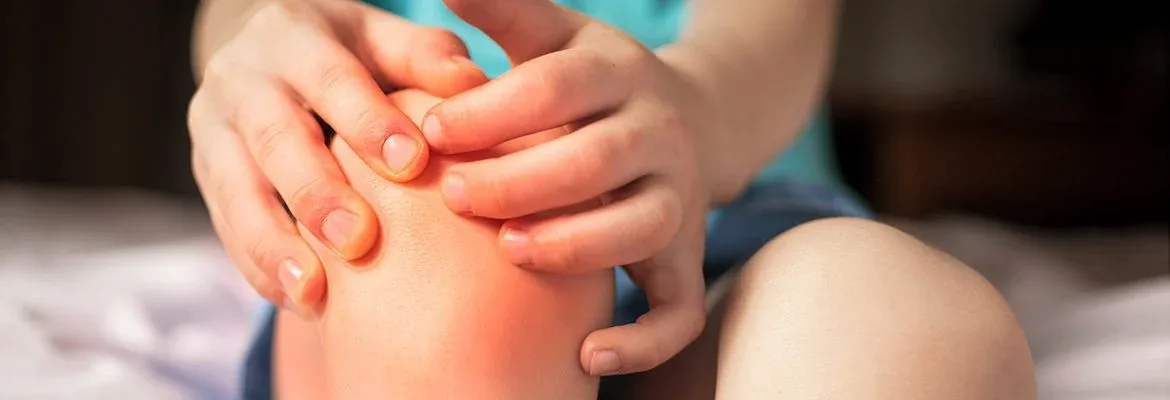High uric acid causes knee gout, an inflammatory arthritis. Uric acid crystals in knee soft tissues can damage and cause severe discomfort. Chronic gout can also lead to kidney disease and other chronic diseases. This article will discuss the symptoms, risk factors, and treatment options for knee gout.
I. Explanation of knee gout and its prevalence

Uric acid crystals in the knee joint cause gout. This can cause inflammation, swelling, and severe pain. Generally, gout occurs when the levels of uric acid in the blood are too high, leading to urate crystals in the one or more joints. High blood pressure, renal illness, and gout history increase knee gout risk. In addition, an unhealthy diet that is high in purine-rich foods can also improve one or more joint’s risk of developing gout. The prevalence of knee gout is rising, and without a proper treatment plan that may include nonsteroidal anti-inflammatory drugs, weight loss, and lifestyle changes, knee gout can lead to permanent damage to the joint and a higher likelihood of future attacks.
II. What is Knee Gout?

knee gout
Uric acid crystals in joints produce knee gout and inflammatory arthritis. Chronic, gout related inflammation caused by high blood uric acid levels destroys joints. Symptoms of knee gout include severe pain and joint inflammation that can limit the range of motion. Purine-rich foods, kidney disease, high blood pressure, and a history of gout can trigger acute attacks of gout flare-ups. Treatment plans for knee gout may involve nonsteroidal anti-inflammatory drugs, weight loss, and a healthy diet to reduce levels of purines in the body. Early diagnosis and management can prevent permanent damage and future attacks of knee gout.
· Causes of knee gout
Knee gout is inflammatory arthritis caused by uric acid causing kidney stones. Kidneys remove uric acid. High blood uric acid can create crystals that lodge in the knee joint, causing discomfort, inflammation, and swelling.
Chronic gout or excessive blood uric acid can cause knee gout. Kidney illness, high blood pressure, and other chronic disorders increase the risk of knee and gout flare up back-ups.
Knee gout is caused by diet. Red meat, shellfish, and alcohol can increase uric acid levels and gout flare-ups. Obesity increases knee gout risk.
In conclusion, chronic gout, high uric acid levels, and a purine-rich diet promote knee gout by forming more uric acid and crystals in the joint. Preventing knee gout and avoiding purine-rich meals can assist.
· Symptoms of knee gout
Uric acid crystals in the knee joint induce knee gout. Symptoms of knee gout can include severe pain, joint inflammation, limited range of motion, and swelling. Gout flare-ups in the knee can lead to permanent joint damage if left untreated. Some people may experience acute gout attacks characterized by intense pain and other symptoms, that last for a few days to a few weeks. Other people with knee gout may have chronic gout symptoms that persist over time. People with knee gout may also experience pain in the ankle or toes. It’s important to seek medical treatment for gout flare-ups to manage symptoms and prevent future prevent gout attacks.
III. Diagnosis of Knee Gout

knee gout
Uric acid crystals in the knee joint cause inflammatory arthritis called knee gout. To diagnose knee gout, a healthcare professional will typically start by examining the patient’s medical history and assessing for risk factors like high blood pressure and kidney disease.
Gout can also be diagnosed with a blood test and tests that evaluate uric acid levels. A joint fluid test may be performed by removing a small fluid sample from the knee joint with a needle. Sediment in the joint fluid and the presence of urate crystals can confirm a diagnosis of gout.
Imaging studies like X-rays, ultrasounds, and MRIs may also be utilized to evaluate the extent of joint damage and any soft tissue involvement.
Prompt diagnosis is crucial in managing knee gout and reducing the severity of future attacks. Joint inflammation and pain can be treated, and long-term joint damage can be avoided with the right approach.
· Medical history and physical examination
When diagnosing knee gout, healthcare professionals will typically examine the patient’s medical history to assess the risk of developing gout and to determine any chronic diseases or conditions contributing to joint pain and inflammation. A physical examination may also evaluate the knee joint, checking for a range of motion and any signs of joint damage or inflammation. Certain blood tests and imaging studies may also be ordered to confirm a diagnosis of gout and assess the extent of joint damage.
IV. Treatment Options for Knee Gout

knee gout
When it comes to treating knee gout, there are several options. The first step is to manage and control the underlying cause of gout, which is the buildup of uric acid in the body. This can be achieved through medication, lifestyle changes, or both.
Nonsteroidal anti-inflammatory drugs (NSAIDs) are often prescribed to relieve gout knee pain, and inflammation. Acute bouts of gout can also be treated with colchicine. Joint inflammation can be treated with corticosteroids if necessary.
Preventing future attacks can be as simple as making some dietary and behavioral adjustments, including sticking to a healthy weight, avoiding foods high in purines, and cutting back on alcohol. In addition, ice packs and range of motion exercises can effectively manage pain and reduce inflammation.
Long-term medications may be necessary for people with chronic or severe gout to prevent future attacks. These medications work by reducing uric acid levels in the body or increasing uric acid elimination from the body.
Ultimately, a combination of medication, lifestyle changes, and joint-specific treatment plans can effectively manage knee gout and prevent future damage to the joint. People with knee gout can lead healthy and pain-free lives with proper treatment and management.
· Medication (NSAIDs, colchicine, corticosteroids)
Knee gout can be treated with nonsteroidal anti-inflammatory drugs (NSAIDs), which alleviate pain and inflammation. Colchicine is another commonly prescribed medication used to for gout affects treat acute attacks. Joint inflammation can develop more severe conditions and sometimes be treated with corticosteroids. A professional medical opinion is necessary for diagnosis and therapy.
· Lifestyle changes (diet, exercise, weight loss)
Symptoms of knee gout include severe pain, joint inflammation, and limited range of motion. While gout is not cured, lifestyle changes can help manage symptoms and prevent future attacks. Maintaining a healthy weight, avoiding purine-rich foods, and staying hydrated can all help reduce the risk of gout flare-ups. Additionally, regular exercise can help improve joint health and decrease the risk of permanent joint damage.
Nonsteroidal anti-inflammatory drugs (NSAIDs) can manage the pain and inflammation associated with gout, but they are not a viable option for fixing the problem permanently. Instead, lifestyle changes should be the foundation of any gout treatment plan.
To those who suffer from or are at risk for a gout attack, talk to your doctor about developing a personalized treatment plan that includes lifestyle changes. By managing your gout, you can reduce the risk of future attacks and improve your overall health and well-being.
V. Prevention of Knee Gout

knee gout
Preventing knee gout mainly involves making lifestyle changes. These adjustments include avoiding purine-rich meals, including shellfish, organ meats, and red meat, maintaining a healthy weight, and drinking lots of water. Likewise, regular exercise helps boost joint health and lessen the likelihood of permanent harm. You should get your doctor’s approval before beginning any new workout program. By making these changes, you can reduce the risk of future attacks and manage the pain and inflammation associated with gout more effectively.
· Avoiding high-purine foods
Gout flare-ups can cause severe pain, joint inflammation, and permanent damage if not managed appropriately.
One way to manage gout symptoms is by avoiding high-purine foods. Purines are compounds found in some foods that can enhance uric acid levels in the blood. Some examples of high-purine foods include organ meats, red meat, shellfish, and alcohol.
By limiting or avoiding these foods, people with gout can reduce their risk of future attacks and manage their uric acid levels. Other lifestyle changes, including weight loss and regular exercise, can help control gout symptoms and reduce the risk of kidney disease.
As there is no cure for gout, a treatment plan that includes avoiding high-purine foods can help prevent and treat gout’ flare-ups and reduce the risk of joint damage. Speaking with a healthcare provider for personalized guidance on managing gout signs and symptoms and reducing the risk of future attacks is essential.
· Drinking plenty of water
Drinking plenty of water is a recommended lifestyle change for people with gout. The danger of kidney stones, a typical complication of untreated gout itself, can be mitigated by drinking enough water, which helps drain the body of excess uric acid. In addition to lowering joint inflammation and promoting a healthy weight, drinking at least eight glasses of water daily can manage gout symptoms. Despite its potential benefits, water should not be used in place of the care provided by a medical practitioner.
· Regular exercise
Regular exercise helps prevent and manage many health issues. Physical activity boosts heart, brain, and bone health.
Exercise can also help manage diabetes, treat high blood pressure,, and arthritis. It reduces joint pain, stiffness, and blood sugar.
Adults should engage in at least 150 minutes of aerobics with moderate intensity and two days of muscle-strengthening each week.
Brisk walking, cycling, swimming, and dancing are moderate-intensity aerobic exercises. Weightlifting, resistance bands, push-ups, and squats are strength-training exercises.
Regular exercise can also improve mood and reduce anxiety and despair.
Before starting a new fitness plan, consult a doctor, especially if you have pre-existing health concerns or have been sedentary for more than one joint.
VI. Frequently Asked Questions (FAQs)
- What is gout in the knee?
Uric acid crystals in the knee joint cause gout. This causes knee pain, edema, and inflammation.
- What are the symptoms of recurrent gout, in the knee?
Gout symptoms in the knee include pain and swelling in the knee joint, redness and warmth in the affected joint area, and limited range of motion due to stiffness and discomfort.
- How is gout in the knee treated?
Treatment for gout in the knee may include medication to reduce inflammation and pain, lifestyle changes such as weight loss and dietary modifications to reduce purine-rich foods, and rest and ice to alleviate symptoms.
- Can gout in the knee cause permanent damage?
Gout in the knee can lead to permanent joint damage worsening pain and deformity if left untreated.
- Who is at risk for gout in the knee?
People with a history of gout, kidney disease, high blood pressure, or who consume a diet high in purine-rich foods may be at increased risk for gout in the knee.
VII. Conclusion:
In conclusion, gout in the knee is a form of arthritis caused by high uric acid levels in the body. Left untreated develop gout can lead to severe pain, inflammation, and potential joint damage. However, effective treatment options diagnose gout such as medications, lifestyle changes, and rest are available. Maintaining a healthy weight, avoiding purine-rich foods, and managing underlying conditions such as high blood pressure and kidney disease can help reduce the risk of future gout flare-ups. If you suspect gout in the knee, seeking medical attention promptly to prevent long-term complications is important.
· Recap of the importance of identifying knee gout as a cause of knee pain
Knee gout is a type of arthritis that involves inflammation. It occurs when uric acid crystals accumulate in the knee joint. High uric acid and high levels of the uric acid level alone, are responsible for chronic gout, which can lead to severe pain and joint damage. Symptoms of knee gout include joint pain, swelling, and reduced range of motion. Identifying knee gout as a cause of knee pain is crucial to prevent permanent joint damage. People with a medical history of kidney disease and high blood pressure, and those who consume purine-rich foods are at higher risk for gout. Treatment plans for knee gout include nonsteroidal anti-inflammatory drugs, weight loss, and a healthy diet to reduce levels of purines. Ice packs and rest can help relieve acute attacks, but advanced gout may require more aggressive treatment. If left untreated, knee gout can lead to chronic conditions and future episodes, highlighting the importance of early diagnosis and prompt treatment.
· Encouragement to seek medical attention if experiencing knee pain.
Knee pain can signify various health conditions, including knee gout. Knee gout is a form of inflammatory arthritis caused by the buildup of uric acid crystals in the knee joint, leading to severe pain and joint damage. If you’re experiencing knee gout pain, seeking medical attention immediately to determine the cause and receive an accurate diagnosis is important. Early detection and treatment can prevent permanent damage and future attacks. Don’t hesitate to seek medical care immediately talk to your healthcare provider about your symptoms and treatment options
